Originally posted on December 25, 2023 @ 5:20 pm
Are you wondering if you can plant black-eyed peas that you bought from the grocery store? You’re not alone! Many gardeners have the same question. The good news is that, in most cases, store-bought black-eyed peas can be successfully planted and grown into mature plants. However, there are a few factors you should consider to ensure the best results.
The viability of the seeds can be affected by their age and processing. Older seeds may have a slower germination rate, while seeds that have been processed, such as drying them in ovens, may be less likely to sprout. The storage conditions of the seeds, both in stores and in your pantry, can also impact their viability.
Before planting the seeds, it’s a good idea to test their germination. This can be done using the paper towel method, where you place the seeds between moist paper towels and check regularly for sprouting. Soaking the seeds overnight before planting can also improve their chances of successful growth. And if the germination rates are low, overplanting multiple seeds in each hole can increase the odds.
It’s important to consider the variety of black-eyed peas you’re growing, as well as whether they are hybrid or open-pollinated. Store-bought seeds may not specify the variety, so you may need to be prepared for different growth habits. And while hybrid seeds may not produce identical plants, open-pollinated seeds should yield similar ones.
When it comes to growing black-eyed peas, they prefer warm soil, so it’s best to plant them when the soil temperatures are at least 70°F. Covering the soil with clear plastic can raise the temperature and speed up germination. Climbing varieties will need support to prevent them from sprawling on the ground.
Once your black-eyed peas are ready to harvest, you can enjoy them at different stages. Immature pods can be used like green beans, while semi-mature pods with green black-eyed peas can also be harvested. For dried beans, allow the pods to dry on the plant until they are dry and brittle. Then, simply harvest the mature seeds for cooking or saving for future planting.
Growing black-eyed peas from grocery store seeds has its benefits. They are nitrogen-fixing plants that can improve soil fertility. Plus, they are rich in dietary fiber, protein, folate, iron, and other micronutrients. These versatile legumes can be used in a variety of dishes, from soups and stews to salads.
So go ahead and give it a try! With the right considerations and techniques, planting grocery store black-eyed peas can be a rewarding gardening experience that yields tasty results.
Table of Contents
Key Takeaways:
- Store-bought black-eyed peas can be successfully planted and grown, but their viability can be affected by factors such as age, processing, and storage conditions.
- Testing the germination of the seeds and soaking them overnight before planting can improve their chances of successful growth.
- Consider the variety of black-eyed peas being grown and whether the seeds are hybrid or open-pollinated.
- Black-eyed peas prefer warm soil, so plant them when soil temperatures are at least 70°F and cover the soil with clear plastic to raise the temperature.
- Provide support for climbing varieties to prevent them from sprawling on the ground.
- Harvest black-eyed peas at different stages, from immature pods to dried beans.
- Growing black-eyed peas from grocery store seeds can improve soil fertility and provide a nutritious harvest.
Factors Affecting the Viability of Store-Bought Black Eyed Peas
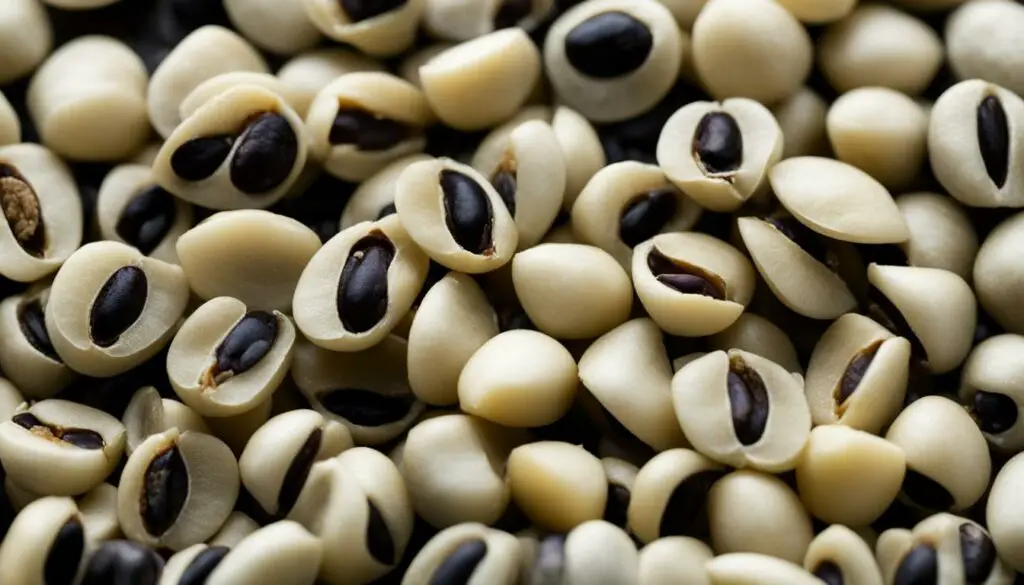
The viability of store-bought black-eyed peas can be influenced by several factors. Understanding these factors is crucial in determining the success of germination and growth when planting these seeds. Let’s explore the key elements that affect the viability of store-bought black-eyed pea seeds:
Age of Black Eyed Pea Seeds
The age of the seeds plays a significant role in their viability. Older seeds tend to have a slower germination rate compared to fresher ones. It’s essential to consider the age of the black-eyed pea seeds you purchase to optimize the chances of successful growth.
Processing of Black Eyed Pea Seeds
The processing methods used for black-eyed pea seeds can impact their ability to sprout and thrive. Seeds dried in large ovens may experience reduced viability. Understanding how the seeds were processed can help in selecting seeds that have undergone suitable processing techniques.
Storage Conditions of Black Eyed Pea Seeds
The storage conditions of the seeds, both in stores and in your pantry, can significantly affect their viability. Improper storage, exposure to excessive heat or moisture, or extended periods of storage can compromise the germination potential of the seeds. It’s crucial to consider the storage conditions of the seeds before making a decision to plant.
This image visually represents the key factors that impact the viability of store-bought black-eyed pea seeds, enhancing our understanding of their germination potential.
By considering the age of the seeds, processing methods, and storage conditions, you can make informed choices when selecting store-bought black-eyed peas for planting. The next section will delve into the process of testing the germination of these seeds to further ensure their viability and maximize your chances of successful growth.
Testing the Germination of Store-Bought Black Eyed Peas
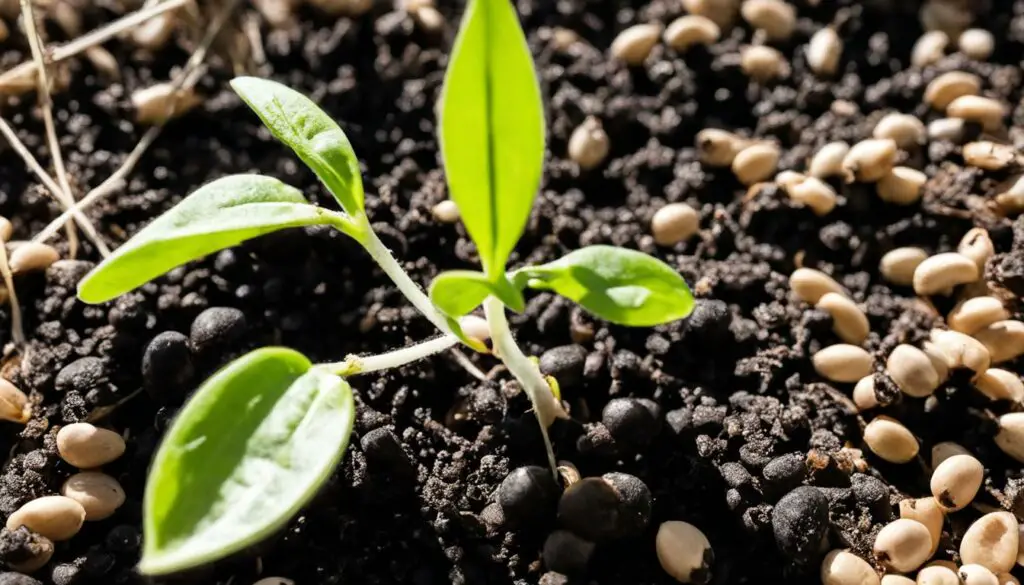
Before planting store-bought black-eyed peas, it is recommended to test their germination to determine their viability.
The paper towel method is a simple and effective way to test the seeds.
Place the seeds between moist paper towels, keep them in a plastic bag or container, and check regularly for sprouting.
This method can help you determine the viability of the seeds and decide whether to plant them.
| Advantages of Using the Paper Towel Method for Germination Testing |
|---|
| 1. Easy to set up and monitor |
| 2. Provides a clear visual indication of germination progress |
| 3. Allows for testing multiple seeds at once |
| 4. Saves time and resources by avoiding direct planting of non-viable seeds |
Note: If using the paper towel method, it is important to maintain the moisture level in the paper towels throughout the testing period. If the paper towels dry out, the seeds may not be able to germinate properly.
Soaking Seeds and Overplanting for Improved Growth
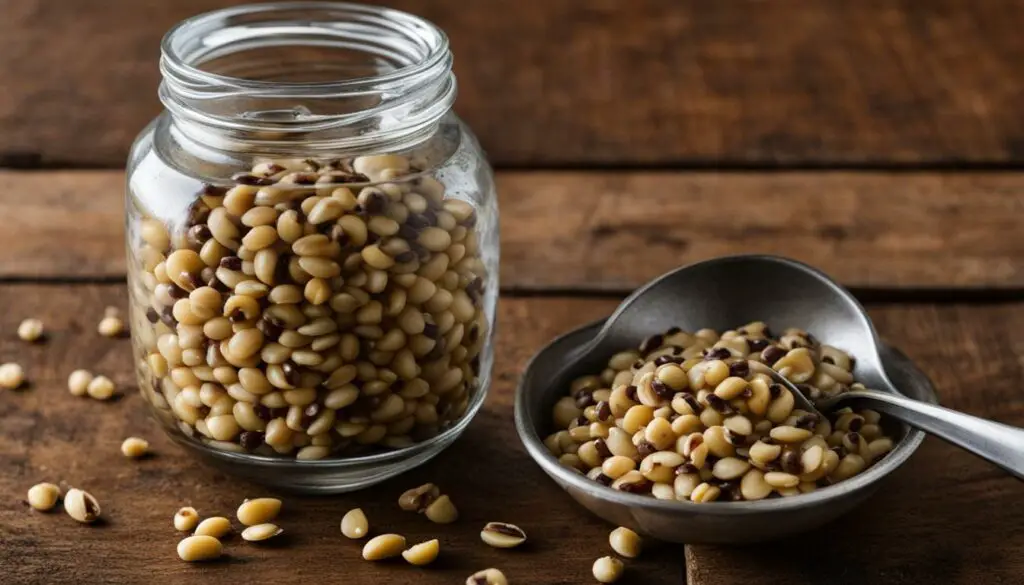
Soaking black-eyed peas seeds before planting can be beneficial for their overall growth and development. By soaking the seeds overnight, you can enhance their chances of successful germination and ultimately improve the growth of your black-eyed pea plants. Soaking the seeds helps to soften the seed coat, making it easier for the seed to absorb water and essential nutrients, which are crucial for germination. The process of soaking also kickstarts the rehydration of the seed, activating enzymes that promote growth.
Overplanting black-eyed peas seeds is another effective technique for maximizing growth potential. Planting multiple seeds in each hole increases the likelihood of successful sprouting, especially if the germination rates are low. This approach compensates for any potential seeds that may fail to germinate, ensuring a higher chance of achieving a productive black-eyed pea crop. However, it’s vital to maintain a proper spacing between the overplanted seeds to allow adequate room for each seedling to grow without competing for resources.
When transplanting black-eyed pea seedlings, it’s crucial to handle them with care to avoid damaging the delicate roots. Legumes, including black-eyed peas, are known to have sensitive root systems and don’t tolerate transplanting well. Transplants may experience stunted growth or fail to thrive altogether. If starting seeds indoors, it’s best to use biodegradable pots and plant the entire pot directly into the ground, minimizing root disturbance.
“Soaking black-eyed peas seeds can enhance seed germination and improve overall growth, while overplanting can compensate for low germination rates and maximize productivity.”
Overall, soaking seeds and overplanting are useful techniques to promote improved growth and increase the chances of a successful harvest. By giving your black-eyed peas a head start through proper hydration and strategic planting, you can enjoy a bountiful crop of these nutritious and delicious legumes.
Considerations for Growing Black Eyed Peas from Grocery Store Seeds

When embarking on the journey of growing black-eyed peas from grocery store seeds, there are important considerations to keep in mind. One crucial aspect is the variety of black-eyed peas being grown. Since grocery store seeds may not specify the exact variety, it’s essential to be prepared for the possibility of different growth habits.
Black-eyed peas come in two main types: pole and bush varieties. Pole black-eyed peas are known for their climbing nature and require support structures like trellises or stakes. On the other hand, bush black-eyed peas have a compact growth habit and do not need additional support. When utilizing store-bought seeds, it’s not always clear which type you will get, so be prepared to adapt your planting methods accordingly.
Another consideration is whether the seeds are hybrid or open-pollinated. Hybrid seeds are the result of crossbreeding different varieties, which can lead to unique characteristics but may not produce plants identical to the parent plant. Open-pollinated seeds, on the other hand, have been naturally pollinated and are more likely to produce plants similar to the parent. Understanding the type of seeds you have can help you plan for the expected outcomes of your black-eyed pea garden.
To summarize, when growing black-eyed peas from grocery store seeds, consider the variety of black-eyed peas, such as pole or bush, and whether the seeds are hybrid or open-pollinated. These factors will influence how you plant, support, and manage your black-eyed pea plants.
Tips for Successful Growth of Black Eyed Peas
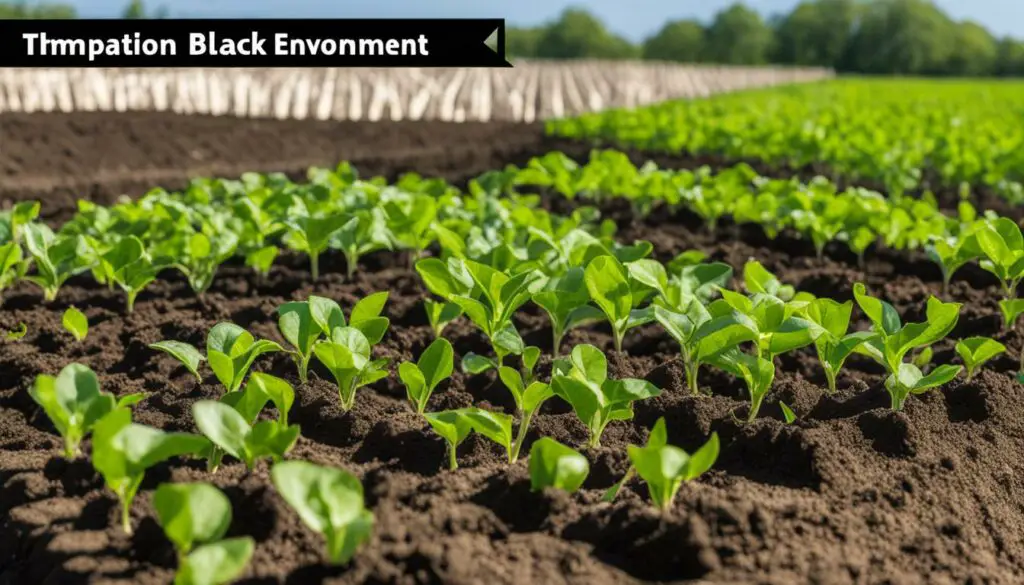
To ensure successful growth of black-eyed peas from grocery store seeds, there are several tips to keep in mind. Black-eyed peas prefer warm soil, so it’s best to plant them when soil temperatures are at least 70°F. It’s also important to cover the soil with clear plastic to raise the ground temperature and speed up germination. Once the black-eyed peas germinate and start growing, it’s important to provide support for climbing varieties to prevent them from sprawling on the ground.
Growing conditions for black-eyed peas are crucial for a successful harvest. Here are some tips to help your black-eyed peas thrive:
1. Planting in Warm Soil: Black-eyed peas are warm-season crops, and they prefer soil temperatures of at least 70°F. Wait until the soil has warmed up before planting to ensure optimal growth.
2. Covering the Soil: To raise the ground temperature and speed up germination, cover the soil with clear plastic. This will create a greenhouse effect and provide the warmth and moisture needed for the seeds to sprout.
3. Providing Support: Some black-eyed pea varieties are climbing plants and require support as they grow. Install trellises or stakes to prevent the plants from sprawling on the ground and to encourage upward growth.
4. Adequate Watering: Black-eyed peas require regular watering, especially during dry spells. Keep the soil consistently moist, but be careful not to overwater, as excessive moisture can lead to fungal diseases.
5. Full Sun Exposure: Ensure that black-eyed peas are planted in a location that receives full sun exposure, as they require at least 6-8 hours of direct sunlight each day to thrive.
6. Well-Draining Soil: Black-eyed peas prefer well-draining soil to prevent waterlogged conditions, which can lead to root rot. Add organic matter, such as compost, to improve the soil’s drainage.
7. Fertilization: Prior to planting, incorporate a balanced fertilizer into the soil to provide the necessary nutrients for healthy growth. Alternatively, you can side-dress the plants with compost or a slow-release fertilizer during the growing season.
8. Pest and Disease Management: Keep an eye out for common pests such as aphids, spider mites, and stink bugs. Use organic pest control methods or consult with a local gardening expert to manage these issues. Additionally, practice crop rotation to minimize the risk of disease buildup in the soil.
By following these tips, you can create the ideal growing conditions for your black-eyed peas and enjoy a bountiful harvest.
Harvesting and Using Black Eyed Peas
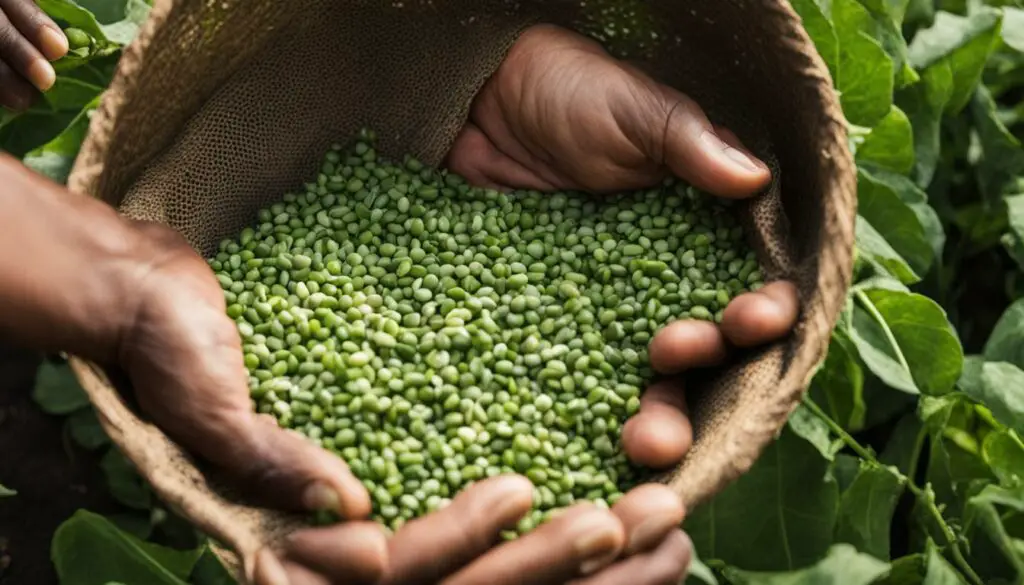
Black-eyed peas can be harvested at different stages depending on personal preference. Immature pods can be harvested like green beans and used in culinary preparations. Semi-mature pods with green black-eyed peas can also be harvested and used. For dried beans, allow the pods to dry on the plant until they are dry and brittle. Once the pods are dry, the mature seeds can be harvested for cooking or saving seeds for the following year. Black-eyed peas are a versatile ingredient and can be used in a variety of dishes such as soups, stews, and salads.
| Stage of Harvest | Description | Uses |
|---|---|---|
| Immature Pods | Harvested when the pods are still tender and green. | – Used in green bean recipes – Can be added to stir-fries – Blanched and frozen for later use |
| Semi-Mature Pods | Harvested when the pods have started to turn yellow and contain green peas. | – Cooked and used in various dishes – Added to soups and stews |
| Dried Pods | Harvested when the pods are dry, brittle, and fully mature. | – Removed from pods and used as dried beans – Stored for future planting or cooking |
Benefits of Growing Black Eyed Peas
Growing black-eyed peas from grocery store seeds can provide numerous benefits for gardeners. These versatile legumes not only offer a bountiful harvest but also contribute to soil improvement and provide valuable nutritional value.
Let’s explore the key advantages of growing black-eyed peas:
- Soil Improvement: Black-eyed peas are nitrogen-fixing plants, which means they have the unique ability to convert nitrogen from the air into a form that plants can utilize. This process, known as nitrogen fixation, helps improve soil fertility by increasing the availability of this essential nutrient. By growing black-eyed peas in your garden, you can naturally enrich the soil and promote healthier plant growth.
- Nutritional Value: Black-eyed peas are not only delicious but also packed with essential nutrients. They are an excellent source of dietary fiber, which aids in digestion and promotes a healthy gut. These peas are also rich in protein, making them a valuable addition to vegetarian and vegan diets. Furthermore, black-eyed peas contain important micronutrients such as folate and iron, which play a crucial role in supporting overall health.
With their ability to enhance soil fertility and provide a nutrient-dense harvest, black-eyed peas offer numerous advantages for both your garden and your plate.
Conclusion
In conclusion, planting black-eyed peas from grocery store seeds is a feasible and rewarding gardening project. By considering key factors and employing effective techniques, successful growth can be achieved. Testing the germination of the seeds, soaking them before planting, and overplanting are all strategies that can increase the chances of favorable outcomes. It is also crucial to take into account the variety of black-eyed peas being cultivated and whether the seeds are hybrid or open-pollinated. With proper care and attention, black-eyed peas can thrive in your garden, providing a bountiful harvest and a delicious addition to your culinary repertoire.
FAQ
Can I plant black-eyed peas from the grocery store?
Yes, you can plant black-eyed peas from the grocery store, but there are factors that can affect their viability.
What factors can affect the viability of store-bought black-eyed peas?
The age, processing, and storage conditions of the seeds can impact their ability to sprout and grow.
How can I test the germination of store-bought black-eyed peas?
You can test the germination of the seeds using the paper towel method. Place the seeds between moist paper towels, keep them in a plastic bag or container, and check regularly for sprouting.
Can soaking the seeds and overplanting improve the growth of black-eyed peas?
Yes, soaking the seeds overnight before planting can improve their chances of successful growth. Overplanting, or planting multiple seeds in each hole, can also increase the chances of successful sprouting.
What should I consider when growing black-eyed peas from grocery store seeds?
It’s important to consider the variety of black-eyed peas being grown and whether the seeds are hybrid or open-pollinated.
What are some tips for successful growth of black-eyed peas?
Black-eyed peas prefer warm soil, so it’s best to plant them when soil temperatures are at least 70°F. Covering the soil with clear plastic can raise the ground temperature and speed up germination. Providing support for climbing varieties is also important.
How do I harvest and use black-eyed peas?
Black-eyed peas can be harvested at different stages depending on personal preference. Immature pods can be harvested like green beans, and semi-mature pods can be harvested with green black-eyed peas. For dried beans, allow the pods to dry on the plant until they are dry and brittle.
What are the benefits of growing black-eyed peas?
Black-eyed peas are nitrogen-fixing plants that can improve soil fertility. They are also a good source of dietary fiber, protein, folate, and iron. They can be used in a variety of dishes and provide a harvest throughout the growing season.
Why should I consider growing black-eyed peas from grocery store seeds?
Growing black-eyed peas from grocery store seeds can be a rewarding endeavor with the right techniques. It allows you to enjoy fresh, homegrown black-eyed peas and potentially improve your soil’s fertility.
Source Links
- https://www.bountifulgardener.com/can-you-plant-store-bought-black-eyed-peas/
- https://gardenerspath.com/plants/vegetables/grow-black-eyed-peas/
- https://growinginthegarden.com/how-to-grow-black-eyed-peas/
See also:
Leave a Reply